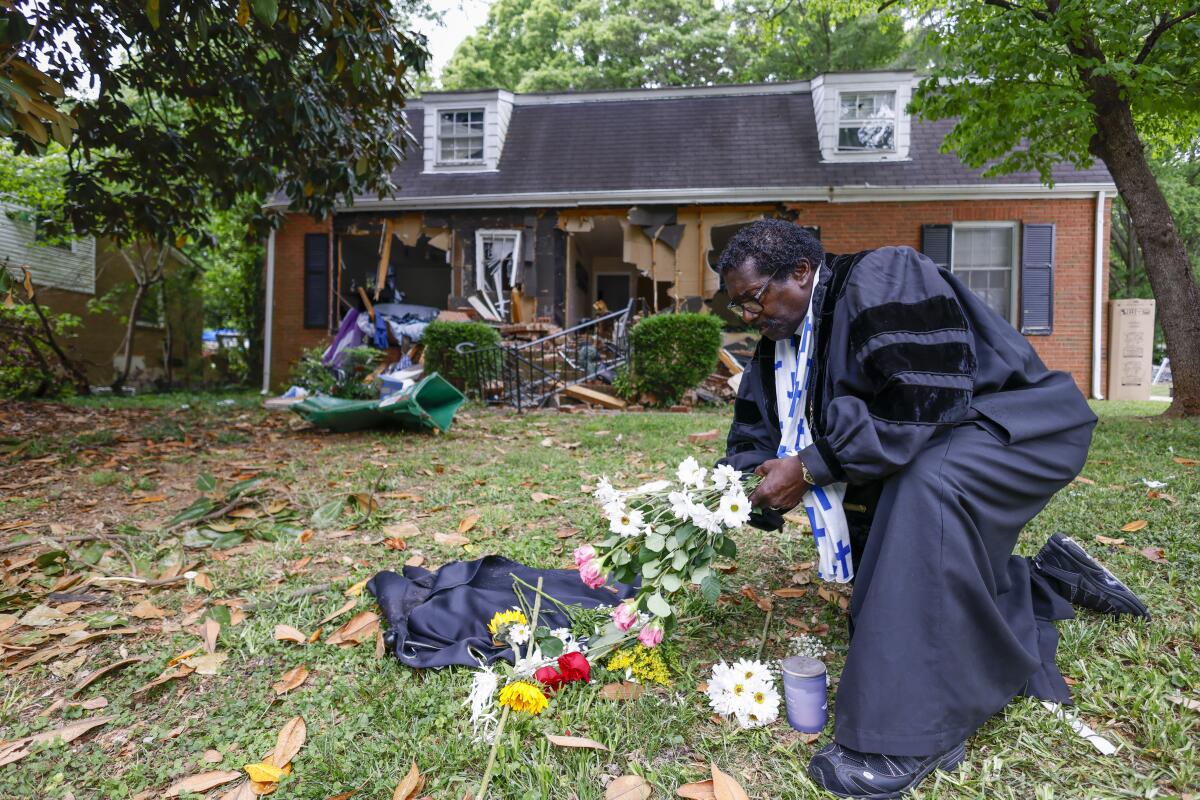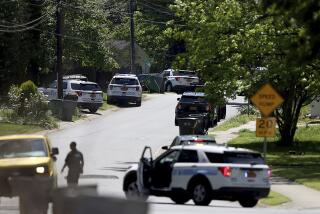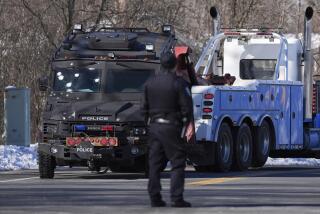4 officers killed in N. Carolina were at disadvantage as shots rained from above, police say

- Share via
CHARLOTTE, N.C. — Four law enforcement officers in North Carolina who were killed while trying to capture a man immediately faced gunfire as they approached, unable to withstand shots from upstairs in a house, authorities said Tuesday.
Still reeling from Monday’s attack — the deadliest against U.S. law enforcement officers since 2016 — investigators in Charlotte said that they weren’t sure whether there was a second shooter and that more work was needed to determine what happened.
“Charlotte isn’t going to be the last place that this happens,” Mayor Vi Lyles said, “but Charlotte will be the place that will heal, that will heal with dignity and respect for everyone.”
A task force made up of officers from different agencies had arrived in the suburban neighborhood to try to capture Terry Clark Hughes Jr., 39, who was wanted for possession of a firearm by an ex-felon and fleeing to elude in Lincoln County, N.C.
Those killed were identified as Sam Poloche and William Elliott of the North Carolina Department of Adult Corrections; Charlotte-Mecklenburg Officer Joshua Eyer; and Deputy U.S. Marshal Thomas Weeks. Four other officers were wounded in the shootout. Hughes was killed.
An AR-15 semiautomatic rifle, a .40-caliber handgun and ammunition were found at the scene.
An AR-15 is able to penetrate traditional body armor and allowed the shooter to “unload several rounds towards our officers within a matter of seconds,” said Charlotte-Mecklenburg Police Chief Johnny Jennings.
He said more than 100 spent rounds were found, though it wasn’t clear how many of those were fired by the assailant. At least 12 officers fired their weapons.
“Even though officers were trying to take cover, they were at a disadvantage because the gunman was up at a higher level and they were returning fire from a lower position,” Jennings said, adding that the gunman was “shooting from upstairs.”
It was the deadliest day for U.S. law enforcement in one incident since five officers were killed by a sniper during a protest in Dallas in 2016.
Hughes’ criminal record in North Carolina goes back more than a decade. It includes prison time and convictions for breaking and entering, reckless driving, eluding arrest and illegally possessing a gun as a former felon, according to state records.
A woman and a girl who were inside the house were cooperating and have not been charged, said Jennings, adding that investigators weren’t pursuing additional suspects.
Jennings said Monday that a second shooter was suspected of firing at police. But by Tuesday, he wasn’t as firm and said that possibility was still being checked.
After a three-hour standoff, the home was torn open. Armored vehicles smashed into it, ripping off windows and entire doorways that were left broken. Several armored vehicles were parked across yards, some with tree branches dangling off them.
Before taking questions from reporters Tuesday, officials expressed sorrow and admiration for the slain and wounded officers.
Eyer was recently honored as a Charlotte-Mecklenburg officer of the month, partly for working to get guns off the streets. The chief said he was killed while responding to help others who were facing gunfire at the scene.
“We saw ... officers going into the line of fire to save their brothers in blue, who have gone down in the act of trying to keep our community safe,” Jennings said. “To me, that’s truly heroic.”
Neighbors said gunfire lasted for several minutes. Rissa Reign was cleaning her house when she heard the first shots. There was a pause, followed by a second set of shots and then a third.
“When we came outside, there were no cops at all, then cops started rushing, rushing, rushing, rushing in,” she said, adding that armored SWAT trucks quickly followed, “going over the grass, everything, and they started shooting again.”
The neighborhood, of one- and two-story, brick homes and small trimmed lawns, is very safe, said Alex Rivera, who lives nearby.
“I see, like, 50 police cars zooming in, and then I hear gunshots,” he said on the front porch of the house he shares with his cousin. “I was scared, because there was so much going on.”
The last marshal killed in the line of duty was in November 2018. Chase White was shot in Tucson by a man wanted for stalking local law enforcement.
The Carolinas Regional Fugitive Task Force, headquartered in Charlotte, comprises 70 federal, state and local agencies collaborating to capture crime suspects.
“This is a loss for the entire country,” said Marshals Service Director Ronald Davis, who traveled to Charlotte. “Losing a deputy, losing task force officers is like losing a family member because, quite frankly, they are family members.”
Verduzco and Collins write for the Associated Press. AP writers John Raby in Charleston, W.Va.; Sarah Brumfield in Silver Spring, Md.; Leah Willingham in Charleston, W.Va.; and Ed White in Detroit contributed to this report.
More to Read
Sign up for Essential California
The most important California stories and recommendations in your inbox every morning.
You may occasionally receive promotional content from the Los Angeles Times.










